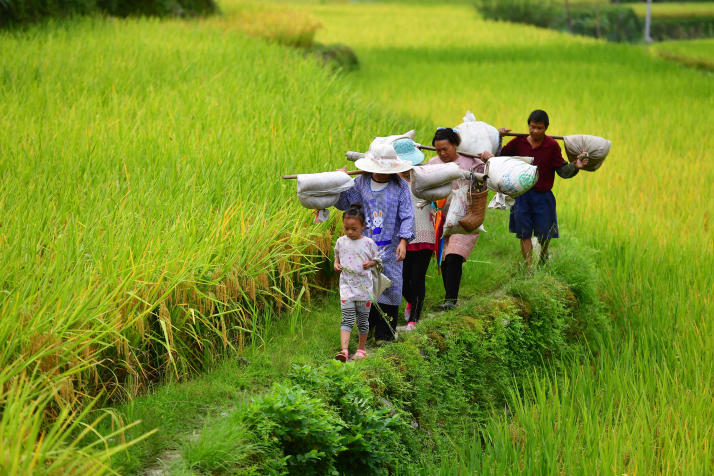|
||||||
|
||||||
| Home Nation World Business Opinion Lifestyle China Focus ChinAfrica Video Multimedia Columnists Documents Special Reports |
|
||||||
|
||||||
| Home Nation World Business Opinion Lifestyle China Focus ChinAfrica Video Multimedia Columnists Documents Special Reports |
| Nation |
| A Crucial Year |
| The Chinese Government stresses poverty alleviation and outlines related work for 2020 |
| By Yuan Yuan · 2019-12-27 · Source: NO. 1 JANUARY 2, 2020 |
 Farmers in a village on the border of Guizhou Province and Guangxi Zhuang Autonomous Region walk back home from the autumn harvest on September 2, 2019 (XINHUA)
China is counting down to the epoch deadline for the campaign to eliminate absolute poverty by 2020. In a recent meeting held in Beijing, the significance of this campaign was further emphasized and more work was outlined for this critical year. Hu Chunhua, member of the Political Bureau of the Communist Party of China Central Committee and head of the State Council Leading Group on Poverty Alleviation and Development, said at the meeting of the leading group held in Beijing that the poverty alleviation campaign has entered a crucial stage. The country's 2020 goal is 10 years ahead of the target set by the UN 2030 Agenda for Sustainable Development.  A farmer in Xizhaozhuang Village, Zaoqiang County, Hebei Province in north China, displays the crop he harvested on October 7, 2019 (XINHUA)
No small task China's poverty alleviation efforts started a few years after it adopted the reform and opening-up policy in 1978. The first regions targeted as the poorest areas were Gansu Province and Ningxia Hui Autonomous Region in northwest China. In 1982, the government started to allocate 200 million yuan ($28.56 million) per year to these regions, marking the beginning of planned, organized and large-scale poverty alleviation efforts nationwide. Over the following decades, China has carried out a series of large-scale development-oriented poverty eradication programs and made concerted efforts to reduce and alleviate poverty. In 2013, President Xi Jinping first put forward the idea of targeted poverty alleviation during a visit to remote Huayuan County in central China's Hunan Province. Since then, the Chinese Government has overhauled poverty alleviation methods by adopting a targeted approach, which requires officials to identify actual impoverished people and the factors that caused their poverty. Under the targeted poverty relief campaign, officials are forbidden from merely handing out relief funds without finding ways of attaining sustainable income for the people. Instead, officials are asked to carry out a thorough assessment of resources, environmental conditions and other local characteristics, and draw up tailored relief plans. Liu Yongfu, Director of the State Council Leading Group Office on Poverty Alleviation and Development, disclosed on December 15, 2019, that for the year, the country helped more than 10 million people and about 340 counties out of poverty. "We have made great progress in helping people living in extreme poverty in Tibet Autonomous Region, Xinjiang Uygur Autonomous Region and parts of Sichuan, Yunnan and Gansu provinces," he said.
Leaving no stones unturned Tibet Autonomous Region in southwest China has been considered one of China's main battlefields against poverty for geographical and historical reasons. On December 23, 2019, the Tibet poverty alleviation office announced that its last 19 counties and county-level districts have climbed out of poverty, meaning the region has eliminated absolute poverty. The areas, all in remote, high-altitude locations, were once among the poorest in the region. About a month earlier, the Central Government had dispensed part of its 2020 funds for poverty alleviation to 28 provincial-level regions across the country, totaling 113.6 billion yuan ($16.2 billion), accounting for 90 percent of that recorded in 2019, according to the Ministry of Finance on November 18, 2019. The ministry said the power to review and approve the use of the poverty alleviation funds should be delegated to county-level governments and the funds should not be used for any projects or tasks unrelated to poverty reduction. In 2015, China launched a resettlement program to relocate poor rural people out of highly impoverished or ecologically degraded areas. It aims to relocate 10 million people through 2020. In 2018 alone, some 2.8 million rural poor were relocated in the country. "We should consolidate achievements in industrial development and employment assistance for poverty relief as well as follow-up support for relocation programs to prevent people from slipping back into poverty," Hu said at the meeting on December 17, 2019. Disease is one of the major causes of poverty. In Yunnan, the population living in poverty caused by illness has decreased by 890,800 since 2016 after the launch of a healthcare project aimed at aiding the poor and sick. In the Outline for Development-Oriented Poverty Alleviation for China's Rural Areas released in 2011, the goal of shaking off poverty is to let rural poor people be free from worries over food and clothing and have access to compulsory education, basic medical services and safe housing. At a symposium on poverty alleviation held in Chongqing in southwest China on April 16, 2019, Hu said that food and clothing needs have been basically resolved for the rural poor, while there is still much to do to ensure access to compulsory education, basic medical services and safe housing. "Government officials should remain vigilant in their poverty alleviation work and continue follow-up support for households that have come out of poverty," Hu stressed. Copyedited by Rebeca Toledo Comments to wanghairong@bjreview.com |
About Us | Contact Us | Advertise with Us | Subscribe
|
||
| Copyright Beijing Review All rights reserved 京ICP备08005356号 京公网安备110102005860号 |